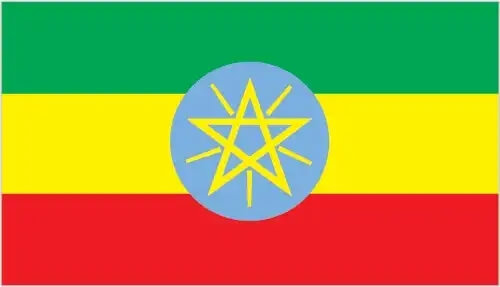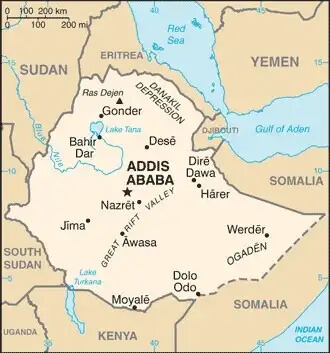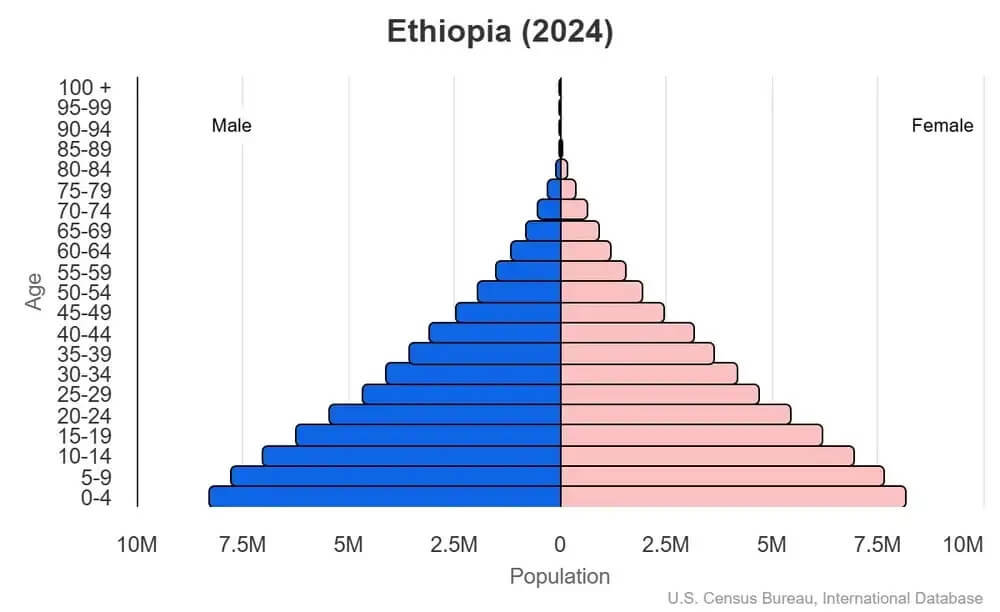World Book
Ethiopia
World Book Index
42


With a score of 42, the country is ranked 149th out of 158 countries in the World Book ranking. (more information)
Introduction
Background
Unique among African countries, the ancient Ethiopian monarchy maintained its freedom from colonial rule with the exception of a short-lived Italian occupation from 1936-41. In recent years, Ethiopia has experienced periods of ethnic-based violence.
Geography
Area
total : 1,104,300 sq km
land: 1,096,570 sq km
water: 7,730 sq km
Climate
tropical monsoon with wide topographic-induced variation
Natural resources
small reserves of gold, platinum, copper, potash, natural gas, hydropower
People and Society
Population
total: 118,550,298 (2024 est.)
Ethnic groups
Oromo 35.8%, Amhara 24.1%, Somali 7.2%, Tigray 5.7%, Sidama 4.1%, Guragie 2.6%, Welaita 2.3%, Afar 2.2%, Silte 1.3%, Kefficho 1.2%, other 13.5% (2022 est.)
Languages
Oromo (official regional working language) 33.8%, Amharic (official national language) 29.3%, Somali (official regional working language) 6.2%, Tigrigna (Tigrinya) (official regional working language) 5.9%, Sidamo 4%, Wolaytta 2.2%, Gurage 2%, Afar (official regional working language) 1.7%, Hadiyya 1.7%, Gamo 1.5%, Gedeo 1.3%, Opuuo 1.2%, Kafa 1.1%, other 8.1%, English (2007 est.)
Religions
Ethiopian Orthodox 43.8%, Muslim 31.3%, Protestant 22.8%, Catholic 0.7%, traditional 0.6%, other 0.8% (2016 est.)
Population growth rate
2.37% (2024 est.)
Government
Government type
federal parliamentary republic
Capital
name: Addis Ababa
Executive branch
chief of state: President TAYE Atske Selassie (since 7 October 2024)
head of government: Prime Minister ABIY Ahmed Ali (since April 2018)
Diplomatic representation in the US
chief of mission: Ambassador BINALF Andualem Ashenef (since 25 February 2025)
Diplomatic representation from the US
chief of mission: Ambassador Ervin MASSINGA (since 4 October 2023)
Economy
Economic overview
low-income, fast-growing Horn of Africa economy; widespread poverty and food insecurity worsened by conflict and environmental factors; landlocked with tensions over seaport access; development aid supporting reforms to boost private-sector growth and financial stability; challenge of creating jobs for growing labor force
Real GDP (purchasing power parity)
$380.895 billion (2024 est.)
$354.926 billion (2023 est.)
$332.97 billion (2022 est.)
Real GDP per capita
$2,900 (2024 est.)
$2,800 (2023 est.)
$2,700 (2022 est.)
Exports
$10.865 billion (2023 est.)
$10.971 billion (2022 est.)
$9.496 billion (2021 est.)
Exports - partners
USA 12%, China 10%, UAE 8%, Saudi Arabia 8%, Netherlands 5% (2023)
Exports - commodities
coffee, garments, dried legumes, cut flowers, oil seeds (2023)
Imports
$22.951 billion (2023 est.)
$24.187 billion (2022 est.)
$20.859 billion (2021 est.)
Imports - partners
China 26%, Djibouti 16%, India 7%, Kuwait 7%, Saudi Arabia 6% (2023)
Imports - commodities
refined petroleum, fertilizers, plastics, raw sugar, cars (2023)
Human Development Index
The country's Human Development Index (HDI) is 0.497, ranking it 180th out of 193 countries tested. (more information)
World Happiness Report
The World Happiness Report ranked the country 145th out of 158 countries tested with a score of 3.566. (more information)



